Physical Tour
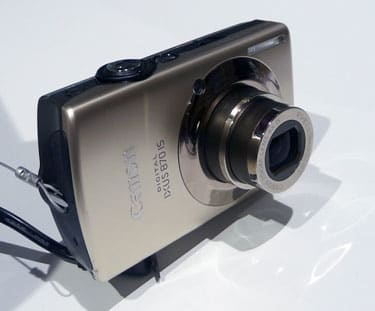
Front
The front of the Canon PowerShot SD880 IS is very clean. Aside from the lens the only other features are the auto focus assist lamp at ten o'clock just next to the lens and the very thin flash found at the top right.

The front of the Canon PowerShot SD880 IS is clean and simple.
**
****Back**
The back is dominated by the three-inch LCD display. This is a very healthy size for a camera this compact, larger than its big brother, the Canon Powershot SD990 IS. All the controls on the back are found to the right of the LCD. The 4-way controller with a rotating dial surrounding it sits in the middle. The 4-way provides quick access to ISO (up), Macro (left), Burst/Timer (down) and Flash (right) options. Above the 4-way are two large and comfortable buttons for Play and Print. Below are two additional buttons that mirror those above for Menu and Display. The only other feature on the back is a small indicator light that sits between the LCD and controls to the left of the Play button.
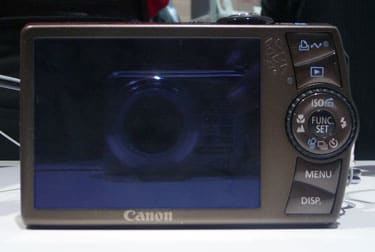
The large 3-inch LCD is a welcome feature.
Sides*
*There's nothing on the left side of the Canon PowerShot SD880 IS. On the right side you find the lanyard loop and a door for the mini USB port.
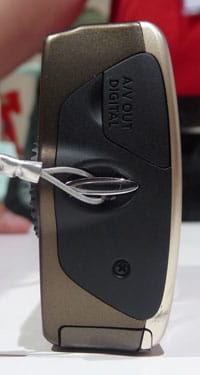
*The Mini USB port and lanyard are
all you find on the sides.
*
The top of the Canon PowerShot SD880 IS has, from right to left, the speaker, shutter button with surrounding zoom toggle, On/Off button, mode switch and a pinhole microphone.

The mode switch on the top has just three options.**
On the bottom you'll find the typical tripod mount and a door that opens to reveal the battery and memory card.

*The tripod mount and a door for the battery and
memory card are found on the bottom.*
Components
Viewfinder
The Canon PowerShot SD880 IS does not have a viewfinder, a feature it loses compared to it's big brother, the SD990 IS.
LCD Screen
One place where the Canon PowerShot SD880 IS outperforms the SD990 IS is the LCD display. The three-inch display is 0.5 inches larger than the SD990IS. It does have the same resolution (230,000 pixels), which means objects on the screen might be a bit less sharp, but frankly we'd rather have the increased real estate.
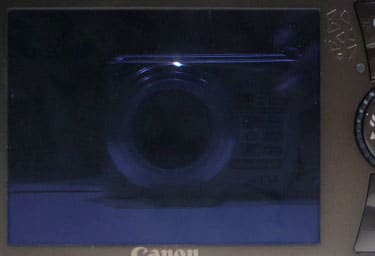
The 3-inch LCD isn't a high-res display, but it's still a nice feature.
**Flash
A tiny flash is located above and to the right of the lens on the front. Unlike the SD990 IS and higher-end PowerShot cameras like the G10, the SD880 IS lacks any controls to regulate the flash output.
**
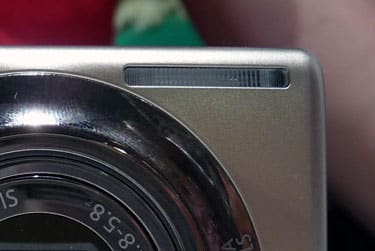
The flash is small and close to the lens.
Lens
The Canon PowerShot SD880 IS sports a 5.0 - 20.0mm, f/2.8 - f/5.8 lens with 4x optical zoom. The lens retracts into the body when you're not using it, so the small and light package can slip easily into your pocket.
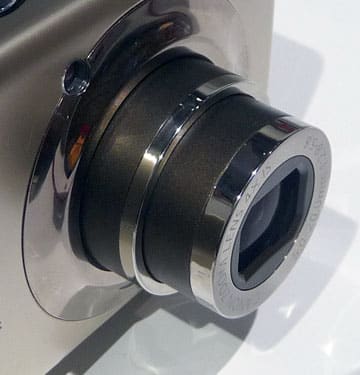
The lens retracts back into the body and offers a 4x optical zoom.
Connections
Like the SD990 IS the Canon PowerShot SD880 IS's only connector is a mini USB port that serves for both data transfers and A/V output.
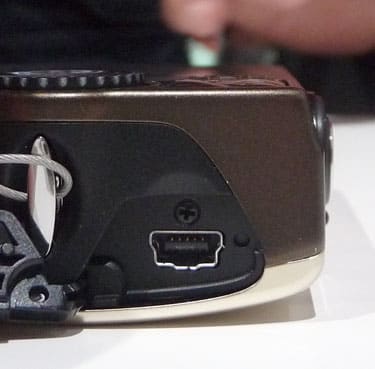
The mini USB port is used for both data transfers and A/V out.
Battery
The battery is found beneath a door on the bottom of the camera. It uses a proprietary rechargeable battery that Canon rates for 310 shots on a single charge.
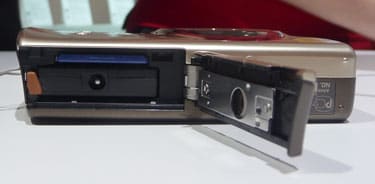
The battery and SDHC card slot are both found in the bay on the bottom.**Memory**
The Canon PowerShot SD880 IS supports SD and SDHC cards, which are currently available in capacities up to 32GB.
Design / Layout
Model Design / Appearance
The Canon PowerShot SD880 IS is smaller and more angular than the SD990 IS, and we found the overall effect more pleasing the SD990 IS's curvy lines. We also appreciated the larger buttons on the back and the increased size of the LCD.
Size and Handling
The SD880 IS measures 3.69 x 2.24 x 0.93 inches (94 x 57 x 24mm) and weighs in at 3.69 ounces (105g). This is slightly smaller and thinner than the SD990 IS and significantly lighter. It means the SD880 is going to fit more comfortably in your pocket or bag. It's not as tiny as the ultra-slim compacts that are out there, however. Despite its smaller size, we actually found the Canon PowerShot SD880 IS easier to handle than the SD990 IS, thanks to the large, comfortable buttons on the back and the larger LCD display.
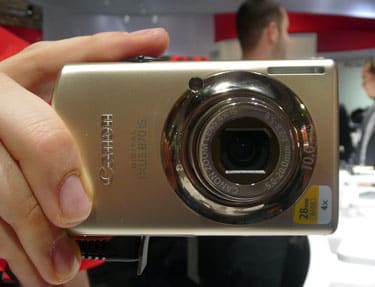
*
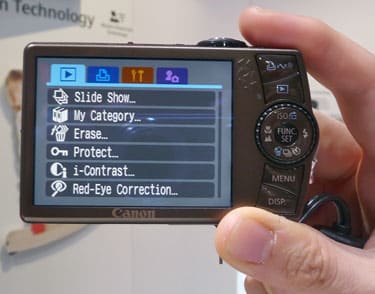
-
The SD880 IS is small, but has large buttons.
Menu
As with other Canon cameras, there are two menu interfaces available on the Canon PowerShot SD880 IS. Hit the Menu button to enter the main menu with a tabbed interface of options. Like the SD990 IS there is no 'Favorites' tab that you find on higher end Canon cameras like the G10.
*

-
The main menu lacks the Favorites tab found on higher-end Canon cameras.
You can also press the center button of the 4-way control to access the Function Set menu. Here you can make quick adjustments to exposure compensation, white balance, My Colors, metering, quality and size. Not all of these options will be available to you, depending on the mode the camera is in.
Ease of Use
The Canon PowerShot SD880 IS is aimed squarely at the amateur consumer market. Although it does offer a Program mode, the only adjustment you can really make is exposure compensation. Most users will use the Auto mode or one of the Scene modes to shoot, and these are easy as pie to use. Combined with a relatively intuitive menu system, comfortable buttons and a large LCD and this is a relatively easy camera to shoot with. That doesn't mean it's perfect: for example, we're not convinced it's a good idea to allow users to switch between Auto and Program mode by simply rotating the dial around the 4-way, this can happen by accident far too easily and many novice users will likely not realize what they've done.
Modes
Auto Mode**
Most users will spend their time in Auto mode. In this mode the only options in the Function Set menu are quality and size. ISO options are Auto and Hi. When the mode switch in in Camera mode, versus Scene or Movie modes, you can move back and forth between Auto and Program modes by rotating the dial surrounding the 4-way. This is easy to do by accident so keep an eye on the mode indicator on your screen.
Movie Mode
When capturing video on the Canon PowerShot SD880 IS you have a choice between Standard, Color Accent and Color Swap modes. The latter two allow you to transform all colors but one to black and white, or swap two colors respectively. When in Movie mode your ISO control becomes a brightness control. The Macro control lets you choose between normal, infinity or macro. In the Function Set menu you have access to white balance, My Colors and size options. Your size options are 640 x 480 or 320 x 240, both at 30 fps.
Drive / Burst Mode**
The Canon PowerShot SD880 IS offers a continuous shooting mode that can be accessed only when shooting in Program mode. To turn this feature on press, down on the 4-way controller and choose Continuous. According to Canon the SD880 IS is capable of shooting 1.3 fps.
Playback Mode
When you hit the play button on the Canon PowerShot SD880 IS you can move from image to image using left/right on the 4-way controller, with images and videos taking up the full screen. If you want to move more quickly you can rotate the dial around the 4-way to scroll through thumbnail images You can also use the zoom toggle to zoom 'out,' which will display a thumbnail grid. As with most cameras from Canon, which has a substantial printer division, a dedicated Print button is prominently available. In this case it's found just above the Play button on the back. The editing options available on the Canon PowerShot SD880 IS are decent. You can rotate, resize, crop, add any of the My Colors options, adjust contrast and perform red-eye correction.
*

-
This is what you see when you rotate the dial when in Playback mode.
Custom Image Presets**
All custom image presets are available when you move the mode switch on the top of the camera to Scene mode. Once here you can rotate the dial around the 4-way controller to select from the plethora of scene modes. Your options are Portrait, Foliage, Snow, Beach, Sunset, Fireworks, Aquarium, Underwater, ISO 3200, Indoor, Kids & Pets, Night Snapshot, Color Accent, Color Swap, Digital Macro and Stitch Assist.
*

-
With the switch in Scene Mode, rotate the dial to select the setting you want.
Control Options
Manual Control Options
The only manual mode the Canon PowerShot SD880 IS offers is Program mode. Unlike the SD990 IS you don't have a full manual mode where you can control shutter speed and aperture. To get to Program mode you set the mode switch on the top to the camera icon. You then rotate the dial to switch between Automatic and Program mode. The major difference between the two are the options available in the Function Set menu.
*

-
Exposure compensation is as advanced as it gets on the SD880 IS.
In Program mode you have access to all the menu features including exposure compensation, My Color and white balance. In Auto mode all you can do is change image quality and size. The other difference is ISO setting. In Program mode you can choose an ISO between 80 and 1600. In Automatic mode you can only choose from Auto or High ISO, which uses ISO-boosting to combat camera shake. One issue with the way you switch between Automatic and Program mode is that the dial is easy to hit by accident, so novices may find themselves switching back and forth between the two without realizing what is happening.
Focus
The Canon PowerShot SD880 IS does not offer manual focus. The auto focus seemed relatively quick, even after panning or zooming. It was not as quick as the auto focus on the G10, however.
ISO
In Auto mode your only ISO options are Auto and High. In Program mode you can choose an ISO between 80-1600. There's also a scene mode for ISO 3200, but photos taken with this scene mode are reduced in size to three megapixels.
*

-
*ISO 3200 is only available as a scene mode
and will reduce your resolution to 3 megapixels.*
White Balance
In Auto mode you don't have access to white balance settings. In program mode you can choose from Auto, Daylight, Cloudy, Tungsten, Fluorescent, Fluorescent H and Custom. The last allows you to manually set the white balance by shooting a white card.
Metering
Metering options are found under the Function Set menu, accessed by hitting the center button of the 4-way. Your options are evaluative, center-weighted and spot. These are only available in Program mode, however. In Auto mode metering is set automatically.
Shutter Speed
The Canon PowerShot SD880 IS offers shutter speeds from 1/660 to 15 seconds, same as the SD990 IS. The big difference between the two is that the SD990 IS has a Manual mode where you can set the shutter speed, while the SD880 IS does not.
Aperture
The Canon PowerShot SD880 IS's aperture ranges from f/28 at the wide end and 5/5.8 at the telephoto end. This is the exact same aperture range as the SD990 IS.
**Image Stabilization
**The Canon PowerShot SD880 IS does not include an image stabilization system beyond boosting ISO in Hi ISO mode.
Picture Quality / Size Options
Quality options are Normal, Fine and Superfine. Size options range from 3648 x 2736 down to 640 x 480 with three additional size options in between. There's also a widescreen capture mode that takes photos at 3648 x 2048.
Picture Effects Mode
Picture effects can be applied while shooting of afterward, in Playback mode, by choosing My Colors from the menu. The available effects include Vivid, Vivid Blue, Vivid Green, Vivid Red, Neutral, Sepia, Black & White, Positive Film, Lighter Skin Tone, Darker Skin Tone, Custom
Conclusion
**
Conclusion**

The Canon PowerShot SD880 IS is an attractive compact point-and-shoot. We like the large three-inch LCD on the back and the easy-to-press buttons. With only three stops on the mode dial this should be a simple camera for beginners to pick up and shoot.
The SD880 IS lacks the manual features found on the SD990 IS, along with that models; optical viewfinder, and drops to 10 megapixels from 14.7. We did find the SD880 easier to use, but given the lack of manual features and lower megapixel spec we would have expected the Canon PowerShot SD990 IS to cost less than the SD990 IS. Instead it's expected to be available at the same $399.99 price point. Unless the price comes down between now and release we feel like the SD880 IS overpriced, whatever its positives.
Specs / Ratings
**Specs Table
**{{manufacturer_specs_table}}{{raw_scores_table}}
Meet the tester

Alfredo Padilla
Editor
Alfredo Padilla is a valued contributor to the Reviewed.com family of sites.
Checking our work.
Our team is here for one purpose: to help you buy the best stuff and love what you own. Our writers, editors, and lab technicians obsess over the products we cover to make sure you're confident and satisfied. Have a different opinion about something we recommend? Email us and we'll compare notes.
Shoot us an email